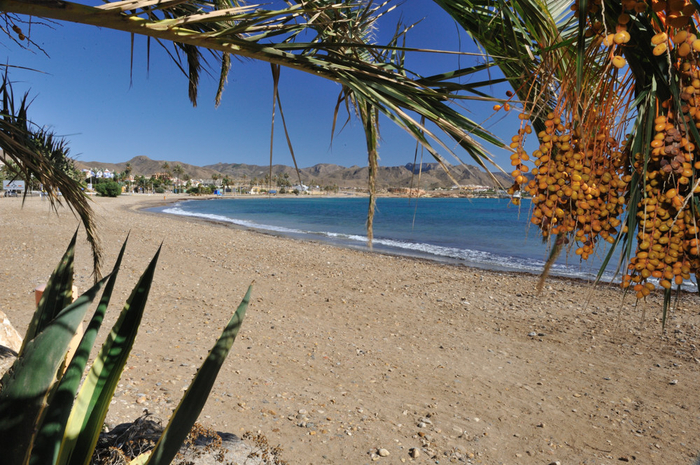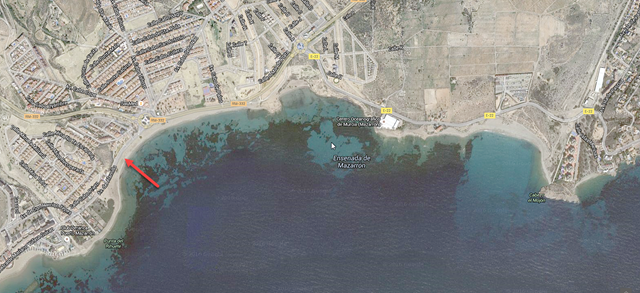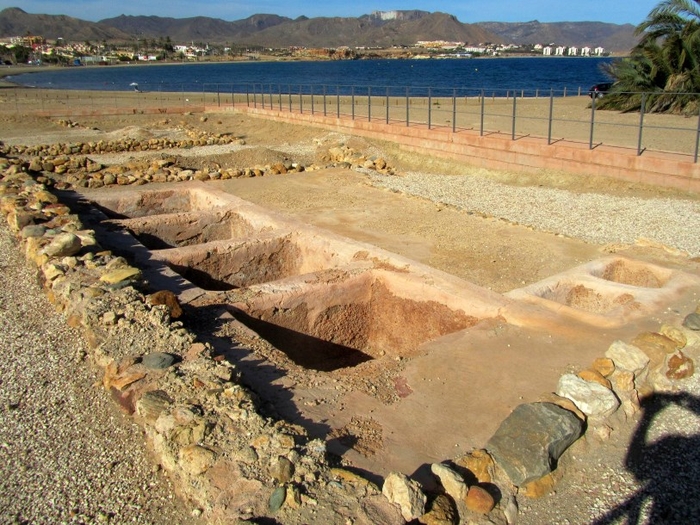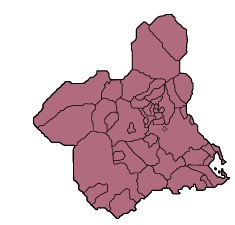Mazarron beaches: Playa del Alamillo
A Blue Flag semi-urban beach popular with windsurfers and anglers in Mazarrón
This semi-urban beach is towards the eastern end of the Mazarrón, and at a length of 600 metres is one of the most popular, lying below a new residential and tourist development and a few cafés, bars and restaurants.
At one end of the beach the remains of a Roman villa and pools used in the production of the pungent garum fish sauce which was widely used 2,000 years ago can be seen, while at the other end is the port and marina of Puerto de Mazarrón. More modern context is provided by the N-332 road behind the beach and there is plenty of parking, both alongside and within the El Alamillo urbanisation.
At the other end, near the remains of the Roman villa, is one of three dog beaches within the municipality, and there is plenty of parking offroad close to both of these locations.

Services and facilities
This is a Blue Flag beach, which means that it has been recognized for aspects such as water quality, the cleanliness of the beach, the level of services and information provided, as well as level of environmental protection by the FEE (Foundation of Environmental Education), which works in 64 countries. During the summer there are portable toilets suitable for use by those with wheelchairs, waste and recycling bins, footwashes, a children’s play area, lifeguard and basic medical cover and wooden walkways down onto the beach.
The larger areas of sand are groomed by the council and the posidonia sea grass deposits which build up during the winter are cleared from the beach in the main tourist season. Substantial meadows of this ocean grass are just offshore, preventing erosion and creating a healthy marine environment.
The beach has a chiringuito (beach bar) during the summer, offering regular entertainment and providing shelter from the sun. The beach is less than half a kilometre from the main seafront promenade and urban beaches of Puerto de Mazarrón, which are very well serviced by the shops and restaurants of the town centre.
There is a bus stop nearby which is on the urban Mazarrón-Murcia route.

Even during the busy summer months the beach is seldom full, and this, along with the fact that it is susceptoble to wind and with the easy parking, makes it attractive to windsurfers. Sailing conditions depend very much on wind strength and direction, and El Alamillo is considered to be very much an “improvers” beach. (The calm, flat waters of the Mar Menor are ideal for beginners, but once a sailor starts to demand greater challenges, then tidal beaches with good launching conditions must be sought on the Mediterranean coast).
Windsurfers tend to stay close to the Playa Negra where launching conditions are best, but it must be emphasised that this beach should only be sailed with an onshore wind, not a side-wind, as even experienced sailors will admit to being blown eastwards down the coast due to a combination of currents, wind direction and wave configuration due to the rocky outcrops along this coast.
There is lifeguard cover only during the summer months, so great care should be exercised out of peak season. Care should be exercised when swimming offshore on windy days and if there are windsurfers it is advisable to swim well away from them; inexperienced sailors can be dangerous as it is extremely difficult for a sailor on a windsurfing board to spot a swimmer snorkelling just below the surface in choppy water.
There is also a launching lane for jetskis and small boats in the summer months, with a jetski hire company operating on the beach.
Out of season, this beach is very popular with fishermen. Mazarrón is unusual in that it permits fishing from its beaches right throughout the year (click to read full information about fishing in the Mazarrón municipality).

The Roman Villa at El Alamillo
For more information about the remains alongside the beach click here.
Modern-day Cartagena was taken by the Romans from the Carthaginians in 209 BC and they swiftly set about exploiting the natural resources of the area, establishing a settlement in what is now Mazarrón, which they named "Ficaria".
In the 1970s a Roman milestone was found near the Convent of "La Purísima", which showed the distance in miles from the Via Augusta (one of the main communications and trade routes created by the Romans, running from Cádiz to the Pyrenees, following the Mediterranean coastline). Mazarrón was one of the ports of call along the route, which was built in parts over an old Iberian road.
Mazarrón has significant mineral resources and the Romans exploited the mines during their period of occupation. A large number of objects and even homes of Roman origin have been found testifying to their presence. Romanization in the area was rapid and largely complete.
But it was the garum fish sauce which particularly attracted the Romans to Mazarrón, as it was both highly prized and highly priced! Mazarrón boasts a very well preserved Roman salting factory, which is located close to the main fishing port area and is well worth a visit for those who are interested in historical locations (see Museo de Salazones, Mazarrón).
On the site in El Alamillo it can clearly be seen that this particular villa was involved in the production of garum, fish sauces, and salted fish products at the same time as the large salt fish factory further along the coast in what is now the fishing port area.
There are six original salt fish tanks in which the the fish would have been macerated to produce garum fish sauce and although there are other salt fish tanks along the coastline, none are as complete as these.
The villa would probably have been abandoned by the end of the 2nd century or early in the 3rd century AD and comprises several rooms around a central courtyard.
Click here for an overview of all 33 beaches in the municipality of Mazarrón, or for more information relating to Mazarrón go to the home page of Mazarrón Today.

